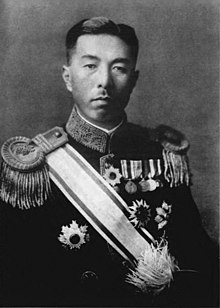
Back فوميمارو كونويه Arabic Fumimaro Konoe Azerbaijani Фумімара Каноэ Byelorussian Фумимаро Коное Bulgarian Fumimaro Konoe BS Fumimaro Konoe Catalan Fumimaro Konoe Czech Konoe Fumimaro German Fumimaro Konoe Spanish Fumimaro Konoe Estonian
This article relies largely or entirely on a single source. (May 2024) |
This article may need to be rewritten to comply with Wikipedia's quality standards. (January 2025) |
Fumimaro Konoe | |||||||||||||||||||||||||||||||||||||||||||||||||||
|---|---|---|---|---|---|---|---|---|---|---|---|---|---|---|---|---|---|---|---|---|---|---|---|---|---|---|---|---|---|---|---|---|---|---|---|---|---|---|---|---|---|---|---|---|---|---|---|---|---|---|---|
近衞 文麿 | |||||||||||||||||||||||||||||||||||||||||||||||||||
 Konoe in 1938 | |||||||||||||||||||||||||||||||||||||||||||||||||||
| Prime Minister of Japan | |||||||||||||||||||||||||||||||||||||||||||||||||||
| In office 22 July 1940 – 18 October 1941 | |||||||||||||||||||||||||||||||||||||||||||||||||||
| Monarch | Shōwa | ||||||||||||||||||||||||||||||||||||||||||||||||||
| Preceded by | Mitsumasa Yonai | ||||||||||||||||||||||||||||||||||||||||||||||||||
| Succeeded by | Hideki Tojo | ||||||||||||||||||||||||||||||||||||||||||||||||||
| In office 4 June 1937 – 5 January 1939 | |||||||||||||||||||||||||||||||||||||||||||||||||||
| Monarch | Shōwa | ||||||||||||||||||||||||||||||||||||||||||||||||||
| Preceded by | Senjūrō Hayashi | ||||||||||||||||||||||||||||||||||||||||||||||||||
| Succeeded by | Kiichirō Hiranuma | ||||||||||||||||||||||||||||||||||||||||||||||||||
| President of the Privy Council | |||||||||||||||||||||||||||||||||||||||||||||||||||
| In office 5 January 1939 – 24 June 1940 | |||||||||||||||||||||||||||||||||||||||||||||||||||
| Monarch | Shōwa | ||||||||||||||||||||||||||||||||||||||||||||||||||
| Preceded by | Kiichirō Hiranuma | ||||||||||||||||||||||||||||||||||||||||||||||||||
| Succeeded by | Yoshimichi Hara | ||||||||||||||||||||||||||||||||||||||||||||||||||
| President of the House of Peers | |||||||||||||||||||||||||||||||||||||||||||||||||||
| In office 9 June 1933 – 7 June 1937 | |||||||||||||||||||||||||||||||||||||||||||||||||||
| Monarch | Shōwa | ||||||||||||||||||||||||||||||||||||||||||||||||||
| Preceded by | Iesato Tokugawa | ||||||||||||||||||||||||||||||||||||||||||||||||||
| Succeeded by | Yorinaga Matsudaira | ||||||||||||||||||||||||||||||||||||||||||||||||||
| |||||||||||||||||||||||||||||||||||||||||||||||||||
| Member of the House of Peers | |||||||||||||||||||||||||||||||||||||||||||||||||||
| In office 12 October 1916 – 16 December 1945 Hereditary peerage | |||||||||||||||||||||||||||||||||||||||||||||||||||
| Personal details | |||||||||||||||||||||||||||||||||||||||||||||||||||
| Born | 12 October 1891 Tokyo, Empire of Japan | ||||||||||||||||||||||||||||||||||||||||||||||||||
| Died | 16 December 1945 (aged 54) Tekigai-sō, Tokyo, Allied-occupied Japan | ||||||||||||||||||||||||||||||||||||||||||||||||||
| Cause of death | Suicide by cyanide | ||||||||||||||||||||||||||||||||||||||||||||||||||
| Political party | Imperial Rule Assistance Association (1940–1945) | ||||||||||||||||||||||||||||||||||||||||||||||||||
| Other political affiliations | Independent (before 1940) | ||||||||||||||||||||||||||||||||||||||||||||||||||
| Spouse | Konoe Chiyoko (1896–1980) | ||||||||||||||||||||||||||||||||||||||||||||||||||
| Parents |
| ||||||||||||||||||||||||||||||||||||||||||||||||||
| Education | |||||||||||||||||||||||||||||||||||||||||||||||||||
| Alma mater | Kyoto Imperial University | ||||||||||||||||||||||||||||||||||||||||||||||||||
| Signature |  | ||||||||||||||||||||||||||||||||||||||||||||||||||
| Japanese name | |||||||||||||||||||||||||||||||||||||||||||||||||||
| Kanji | 近衞 文麿 | ||||||||||||||||||||||||||||||||||||||||||||||||||
| |||||||||||||||||||||||||||||||||||||||||||||||||||
| Part of a series on |
| Statism in Shōwa Japan |
|---|
 |
Prince Fumimaro Konoe (近衞 文麿, Konoe Fumimaro, 12 October 1891 – 16 December 1945) was a Japanese politician who served as Prime Minister of Japan from 1937 to 1939 and from 1940 to 1941. He presided over the Japanese invasion of China in 1937 and breakdown in relations with the United States, which shortly after his tenure culminated in Japan's entry into World War II. Konoe played a central role in transforming Japan into a totalitarian state by pushing through the State General Mobilization Law and by establishing the Imperial Rule Assistance Association while dissolving all other political parties.
Born in Tokyo to a prominent aristocratic family, Konoe graduated from Kyoto University and took up his father's seat in the House of Peers in 1916. He was a member of the Japanese delegation at the Paris Peace Conference following World War I, and served as president of the House of Peers from 1933 to 1937, when he became prime minister on the recommendation of his mentor Saionji Kinmochi. When the Marco Polo Bridge Incident took place a month later, Konoe took a belligerent stance, and it escalated into full-scale warfare. He oversaw the early phase of the Second Sino-Japanese War, including the Battle of Shanghai and Nanjing Massacre, and in 1938 pushed through the State General Mobilization Law, which placed Japan on war footing. He proposed a "Greater East Asia Co-Prosperity Sphere" under Japanese leadership. Konoe resigned as premier in 1939 as Chinese resistance continued and the war dragged on.
Konoe served as chairman of the Privy Council until 1940, when he was again appointed prime minister. He founded the Imperial Rule Assistance Association later that year, and Japan concluded the Tripartite Pact with Nazi Germany and Fascist Italy. Konoe was in office when Japanese troops invaded French Indochina, and he formally recognized Wang Jingwei's government in Nanjing and concluded the Soviet–Japanese Neutrality Pact. Konoe attempted to resolve growing tensions with the United States, but a rigid timetable imposed by the military on the negotiations and his administration's own inflexibility set the two countries on the path to war. Politically isolated, Konoe resigned as premier in October 1941 and was replaced by Hideki Tojo. Six weeks later, the Pacific War broke out after Japan's attack on Pearl Harbor.
Konoe remained a close advisor to Emperor Hirohito until the end of World War II and played a key role in the fall of the Tōjō Cabinet in 1944. At the start of the Allied occupation of Japan in 1945, he briefly served as a minister in the cabinet of Prince Naruhiko Higashikuni, but came under suspicion of war crimes. In December, Konoe committed suicide by ingesting cyanide before he could be arrested by the authorities.